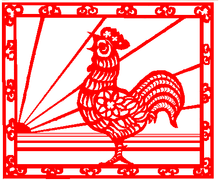Chinese paper cutting
| Subclass of | Art of paper cutting |
|---|---|
| Country of origin | China |
| Intangible cultural heritage status | Representative List of the Intangible Cultural Heritage of Humanity |
| Described at URL | https://ich.unesco.org/en/RL/00219, https://ich.unesco.org/fr/RL/00219, https://ich.unesco.org/es/RL/00219 |

Ebe art of paper cutting (Chinese: 剪紙; pinyin: jiǎnzhǐ) for China insyd wey dey date back go de 2nd century CE, as Cai Lun wey na he be sam court official give de Eastern Han dynasty invent paper.
Chinese paper cutting be sam treasured traditional Chinese art dating back go wen dem develop paper. Paper cutting cam turn popular as sam way wey edey decorate doors den windows as paper wey ecam turn more accessible. Dem create dese elaborate cutting designs plus scissors anaa artwork knives wey ego fi include sam variety of shapes, such as symbols den animals. As paper cam turn more affordable, paper-cutting cam turn one of de most important types of Chinese folk art. Later, dis art form spread go oda parts of de world, plus different regions wey dey adopt dema own cultural styles. Secof de cut-outs wey dem often dey take dey decorate doors den windows, dem samtyms dey refer am as "window flowers" (窗花; chuāng huā) anaa "window paper-cuts". Derm often dey glue dese cut-paper decorations plus de exterior of windows, so say de light from de insyd dey shine through de negative space of de cutout.[1] Usually, dem dey make de artworks from red paper, secof red be associated plus festivities den luck for Chinese culture insyd, but dem dey use oda colours. Normally dem dey use cut-paper artwork for festivals such as Chinese New Year, weddings den childbirth, secof dem dey consider cut-paper artwork say edey symbolize luck den happiness.

